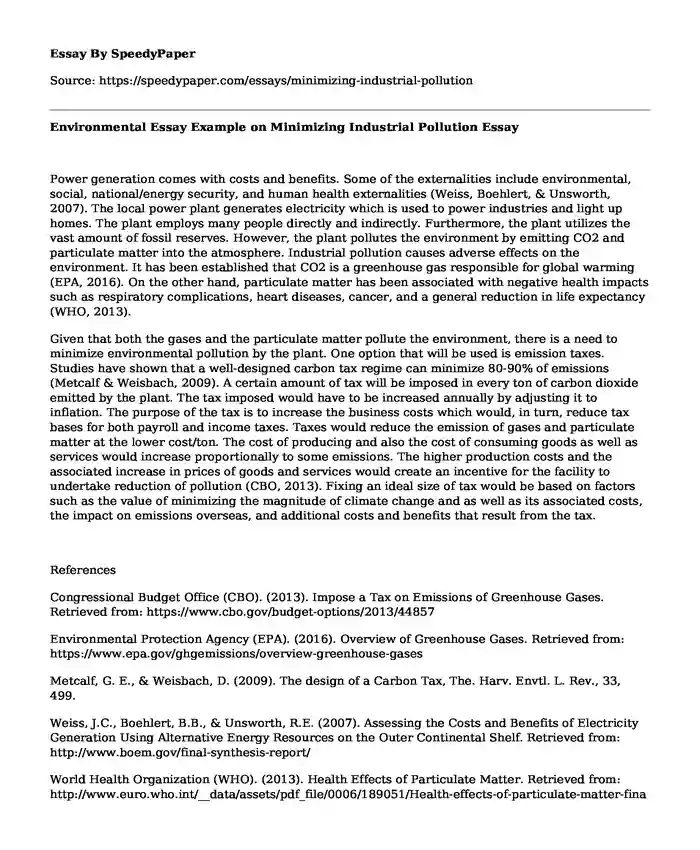
| Type of paper: | Essay |
| Categories: | Environment Ecology Pollution |
| Pages: | 2 |
| Wordcount: | 448 words |
Power generation comes with costs and benefits. Some of the externalities include environmental, social, national/energy security, and human health externalities (Weiss, Boehlert, & Unsworth, 2007). The local power plant generates electricity which is used to power industries and light up homes. The plant employs many people directly and indirectly. Furthermore, the plant utilizes the vast amount of fossil reserves. However, the plant pollutes the environment by emitting CO2 and particulate matter into the atmosphere. Industrial pollution causes adverse effects on the environment. It has been established that CO2 is a greenhouse gas responsible for global warming (EPA, 2016). On the other hand, particulate matter has been associated with negative health impacts such as respiratory complications, heart diseases, cancer, and a general reduction in life expectancy (WHO, 2013).
Given that both the gases and the particulate matter pollute the environment, there is a need to minimize environmental pollution by the plant. One option that will be used is emission taxes. Studies have shown that a well-designed carbon tax regime can minimize 80-90% of emissions (Metcalf & Weisbach, 2009). A certain amount of tax will be imposed in every ton of carbon dioxide emitted by the plant. The tax imposed would have to be increased annually by adjusting it to inflation. The purpose of the tax is to increase the business costs which would, in turn, reduce tax bases for both payroll and income taxes. Taxes would reduce the emission of gases and particulate matter at the lower cost/ton. The cost of producing and also the cost of consuming goods as well as services would increase proportionally to some emissions. The higher production costs and the associated increase in prices of goods and services would create an incentive for the facility to undertake reduction of pollution (CBO, 2013). Fixing an ideal size of tax would be based on factors such as the value of minimizing the magnitude of climate change and as well as its associated costs, the impact on emissions overseas, and additional costs and benefits that result from the tax.
References
Congressional Budget Office (CBO). (2013). Impose a Tax on Emissions of Greenhouse Gases. Retrieved from: https://www.cbo.gov/budget-options/2013/44857
Environmental Protection Agency (EPA). (2016). Overview of Greenhouse Gases. Retrieved from: https://www.epa.gov/ghgemissions/overview-greenhouse-gases
Metcalf, G. E., & Weisbach, D. (2009). The design of a Carbon Tax, The. Harv. Envtl. L. Rev., 33, 499.
Weiss, J.C., Boehlert, B.B., & Unsworth, R.E. (2007). Assessing the Costs and Benefits of Electricity Generation Using Alternative Energy Resources on the Outer Continental Shelf. Retrieved from: http://www.boem.gov/final-synthesis-report/
World Health Organization (WHO). (2013). Health Effects of Particulate Matter. Retrieved from: http://www.euro.who.int/__data/assets/pdf_file/0006/189051/Health-effects-of-particulate-matter-final-Eng.pdf
Cite this page
Environmental Essay Example on Minimizing Industrial Pollution. (2019, Nov 18). Retrieved from https://speedypaper.net/essays/minimizing-industrial-pollution
Request Removal
If you are the original author of this essay and no longer wish to have it published on the SpeedyPaper website, please click below to request its removal:
- QACA and Qatar Charities, Free Essay
- Essay Sample on Employees' Motivation in Cincinnati Financial Corporation
- Heat Transfer, Free Essay in Chemistry
- Free Essay: Impact of Musical Interventions on Language and Cognitive Development
- Essay Example on the Impact of "Gendered" Toys on Children in Barbie Doll Poem
- Free Essay: Madison & Hamilton Analysis of the Federalists Papers
- Free Essay Example - New Software for the Insurance Agency
Popular categories




